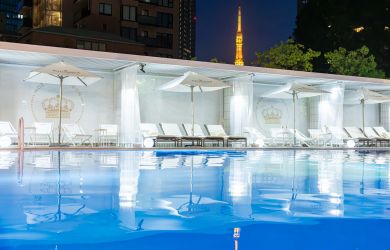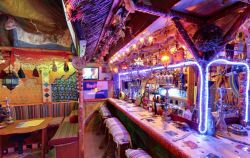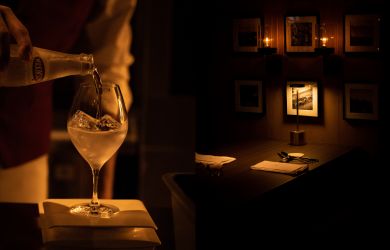
June 11, 2009
Tall Order
Some of Tokyo's iconic buildings are being lost to zoning laws that were intended to improve the city
By Metropolis
Originally published on metropolis.co.jp on June 2009

Nakagin Capsule Tower in Ginza
Photo by Phil Couzens
In the first half of the 20th century, Tokyo was bitten by the modernist bug. The violent upheavals seen in Western art, literature, music and fashion found parallels over here—but it was architecture that provided the most visible and lasting testament to the changes underfoot. Buildings like the Tokyo Central Post Office (1931) in Marunouchi demonstrated the increasing influence of such Western architects as Le Corbusier and concepts like Bauhaus. In the decades following World War II, with industrialization suffocating creativity, postmodernism came to the forefront. Experts considered architect Minoru Takeyama’s colorful Ichibankan (1969) and monochrome Nibankan (1970), situated in the nightlife quarter of Kabukicho, to be the first examples of this new avant-garde spirit.
Today, Ichibankan is completely closed, and Nibankan, whose exterior is riddled with chipped paint and cracked concrete, maintains only a first-floor restaurant in operation. Ownership changed two years ago. During a meeting with the buildings’ present owner, Sankei Hotel, a lodging operator that specializes in business and love hotels, representatives of the company indicated that the future use of the structures has not been decided.
Such a potential reprieve is rare, as the elimination of Japan’s landmark properties becomes routine and calls for preservation are crushed by developers’ wrecking balls.
The challenges facing preservationists are numerous.
Last October, entertainment company Shochiku announced that the Kabuki-za theater in Ginza, Japan’s home for kabuki since it was founded in 1889, will close next year and be reinstalled inside a large office complex by 2013. Reconstructed twice, its 1924 incarnation incorporated a new style of non-burnable building materials. The current five-decade-old building achieved tangible cultural property status in 2002.
Shochiku said in an email statement that the Kabuki-za is an aging structure that is susceptible to earthquakes. “Taking into consideration that its facilities are not barrier-free, we decided that it would be in the best interest of our customers for us to rebuild the theater.”
In addition to the financial hurdles inherent in upgrading aging mechanical and electrical systems, architects believe that revisions to earthquake-proofing requirements within the Building Standards Law in recent decades are also burdensome. “You have to spend a lot of money to make a building seismically sound, and there is no aid from the government to do that,” explains Jun Mitsui, principal architect of JMA Architects in Meguro. “The owner has to basically assume the financial burden himself.”
Crucial, too, has been the financial incentive given to developers. In 2002, then Prime Minister Junichiro Koizumi passed legislation that lifted regulations on zoning and building height in exchange for the establishment of public parks or plazas on any newly constructed properties. Often referred to as an “urban renaissance,” the deregulation was intended to maintain Tokyo’s competitive status with nearby metropolises Hong Kong, Shanghai and Singapore.
“That was the stimulus to Japan’s economic upturn,” says Mitsui of the economic expansion that took place in the middle of this decade. “Property owners wanted to maximize their buildings’ floor space because that is what makes more money.”
Non-property firms with robust real estate assets, like Shochiku, have also been taking notice. Japan Post, which became a pseudo-private entity two years ago, is in the process of constructing a 200m-tall building on the site of the 78-year-old Tokyo Central Post Office on the Marunouchi side of Tokyo station. The curved brick building will eventually incorporate parts of the older structure’s exterior façade in the new design. Last-ditch attempts to save the original building resulted in Japan Post announcing that it will seek tangible cultural property status for the property and retain more of the structure than first planned.

Kabukiza
Last year, film studio Toho acquired Kabukicho’s Koma Stadium theater, a popular venue for enka and musical shows that dates back to 1956. Toho also owns the adjacent Shinjuku Toho Kaikan and plans to redevelop both plots. Publisher Kodansha’s Noma Dojo training facility, established in 1925, was knocked down in late 2007 in favor of a more modern complex.
“In Japan, the idea of scrap-and-build has been dominant for a long time,” explains Kengo Kuma, a leading architect whose firm designed the Suntory Museum of Art at Tokyo Midtown. “So there hadn’t been much attention paid to the preservation of buildings. The debate over the Tokyo Central Post Office, however, has provided a good opportunity for the public to think carefully about the preservation of old architecture.”
Many other preservation pushes have failed. The Sanshin Building (1930), an eight-floor structure that overlooked Hibiya Park and contained elaborate ceilings and columns, was demolished by developer Mitsui Fudosan in 2007. The concrete Dojunkai apartments were innovative housing structures—featuring trash chutes and gas lines—upon their completion between 1924 and 1934 at 16 locations in Tokyo and Yokohama. In 2003, the five-story Otsuka Women’s Apartment House was demolished, and the Aoyama site was replaced three years later by Tadao Ando’s concrete and glass Omotesando Hills shopping center. Just two apartment blocks remain today.
Mitsui believes that as a solution to here-today-gone-tomorrow, Tokyo needs to adopt master planning. “The formation of a master plan will define such things as the height and use of the building,” he says, adding that complications within private land ownership and a lack of government impetus thus far have made such a concept very difficult.
Yet the government does offer some support—albeit through a tradeoff that benefits developers. In exchange for preservation of its notable Mitsui Honkan (1929), Mitsui Fudosan was allowed to develop a nearby site into the 39-floor Nihonbashi Mitsui Tower (2005). The height of the new structure exceeded that permitted by law, but Mitsui was allowed to transfer the unused air rights (i.e., potential additional floor area) of the old building following its preservation.
The Paris-based conservation group Docomomo International, which works to preserve modern buildings, established a Japanese branch in 2000. Its group of experts has designated over 135 local structures as important. In addition to the remaining Dojunkai units and the Tokyo Central Post Office, the list includes Frank Lloyd Wright’s Myonichikan (1921), Tokyo Bunka Kaikan (1961) and the Nakagin Capsule Tower (1972), the Kisho Kurokawa-designed structure of stacked concrete residential modules.
Hiroyuki Suzuki, chairperson of Docomomo Japan and a professor of architecture at Tokyo University, says that the group submits appeals to landowners of listed buildings scheduled for demolition. He sees some hope with regards to preservation, citing the restoration of Tokyo Station’s red brick building, set to be completed in 2013, as an example. “Progress is small to this point,” he says, “but we will continue to make appeals against the demolition of important works because it is essential we do so.”
The group is now focusing its attention on buildings from the 1970s—a move probably too late for the Kenzo Tange-designed Hanae Mori building (1977), the glass-walled Omotesando landmark that is scheduled to be pulled down following the removal of its tenants this year.
As to Ichibankan and Nibankan, Docomomo’s Suzuki says that the group finds Takeyama’s work to be very significant. Yet an approach and time frame for preservation of his buildings has not been determined. “At Docomomo, we realize that there is a connection between modernism and postmodernism that needs to be discussed,” he explains.
Should the near future bring an end to the Kabukicho creations of Takeyama, the man himself says says he would not be irritated, knowing that the business is financially driven. He also looks at Ise Jingu, a Shinto complex in Mie Prefecture whose buildings are dismantled and rebuilt every 20 years in an effort to ensure a new appearance. “I can’t really say if it is positive or negative,” Takeyama explains. “They have been up for 40 years. That’s not too bad. Maybe it is time.”

Minoru Takeyama
A look at a renowned architect’s most famous works in Tokyo
Amid the garish neon flashes of Kabukicho, you’ll find touts cruising for clients, drifting drunks, hostesses hustling off to bars, and the occasional gangster tiff. But in the late ’60s—a time when young architect Minoru Takeyama was commissioned to design a pair of buildings that would house adult entertainment businesses—it wasn’t quite as active.
“Back then, there were not a lot of people around. It was a residential area with low buildings,” says the now retired 75-year-old, who also designed the iconic Shibuya 109 building near Shibuya station. “I wanted to make designs that really stood out, something that caught people’s attention.”
The result was a pair of eight-floor structures that housed bars, clubs and saunas, and that opposed one another to create a sense of balance. The white-striped Ichibankan (1969) is dark and sleek, with a façade reminiscent of a Transformer character whose sides take the shape of arms ready to embrace entering guests. Nibankan (1970) features a “supergraphic” of red, yellow and white lines and concentric circles emblazoned across its sloping sides of concrete and metallic sheets.
For that colorful image, Takeyama employed graphic designer Kiyoshi Awazu, who passed away earlier this year. The concept was for the paint to be cheap and replaced roughly every five years with a new design—a reflection of Kabukicho’s inherently mercurial nature.
Charles Jencks’ influential 1977 book, The Language of Post-Modern Architecture, splashed Nibankan on its cover. “Takeyama responded to the highly festive, if often garish, character of the urban milieu almost to the point of celebrating it rather than concentrating on structural systems, industrial technology, and rational design,” wrote Botond Bognar in 1995’s The Japan Guide. “As a result, the buildings became early representatives of an openly populist mode of design, yet they did so without falling victim to a trivial commercialism.”
Both structures are now mainly shut, yet experts believe their vitality remains. “Takeyama’s approach puts two contradicting concepts together,” says Martin van der Linden, president of Tokyo-based van der Architects. “He has created buildings that are an expression of the surrounding urban fabric but that also stand completely apart from it. There have been very few buildings worldwide that have archieved this feat, let alone in Japan.”
The Europe-based preservation society Docomomo (www.docomomojapan.com) maintains a list of buildings it deems important. Here are a few in Tokyo.
Nakagin Capsule Tower
A structure that balances 140 concrete boxes over 14 floors between Ginza and Shiodome
8-16-10 Ginza, Chuo-ku. Nearest stn: Ginza, Higashi-Ginza or Shimbashi.
Tokyo Central Post Office
The hands of its iconic clock have been removed, and scaffolding surrounds much of the site. Timeless it is not.
2-7-2 Marunouchi, Chiyoda-ku. Nearest stn: Tokyo, Marunouchi, south exit.
Dojunkai Apartments
A short stroll from Ueno Station reveals one of the two examples still standing of these apartments, constructed to provide housing following the Great Kanto Earthquake of 1923.
4-5 Higashi Ueno, Taito-ku. Nearest stn: Ueno, Asakusa exit.
Myonichikan
“House of Tomorrow” is one of two buildings by Frank Lloyd Wright remaining today in Japan.
2-31-3 Nishi-Ikebukuro, Toshima-ku. Nearest stn: Ikebukuro, west exit.
Other landmarks worth a look
Kabuki-za
“Sayonara” performances will extend between January and April of next year. Catch one before it’s gone.
4-12-15 Ginza, Chuo-ku. Nearest stn: Higashi-Ginza, exit 3.
Hanae Mori
The area around Omotesando crossing has many notable buildings. One of the first to give the neighborhood its character won’t be around much longer.
3-6-1 Kita Aoyama, Minato-ku. Nearest stn: Omotesando or Meiji-Jingumae.
Ichibankan and Nibankan
These two don’t stand out like they once did, but they’ve certainly achieved landmark status in Kabukicho.
2-20-9 Kabukicho and 2-3-14 Kabukicho, Shinjuku-ku. Nearest stn: Shinjuku.







